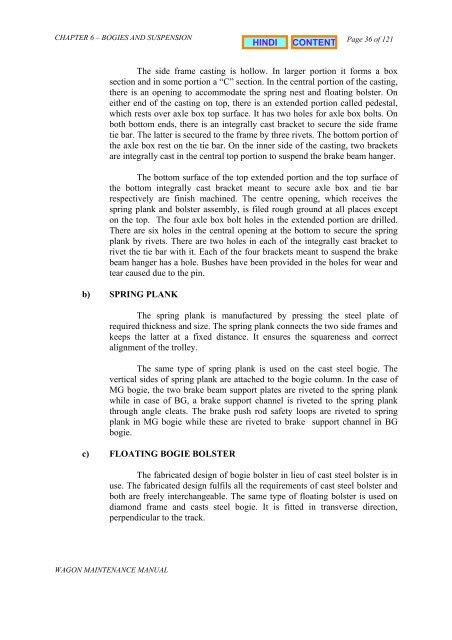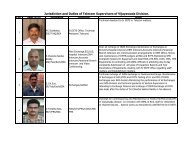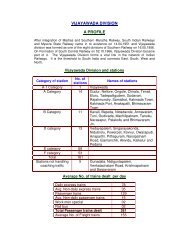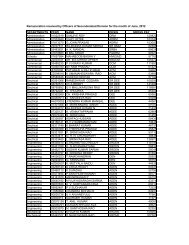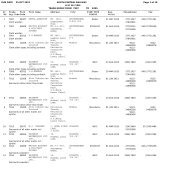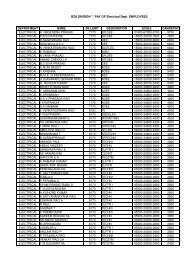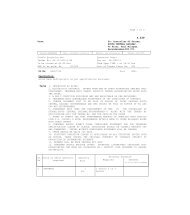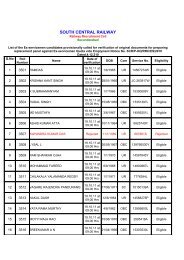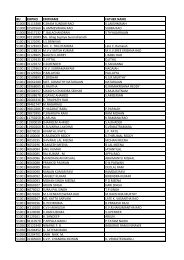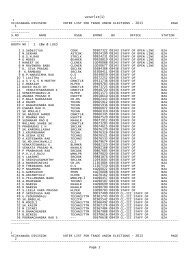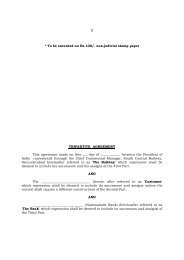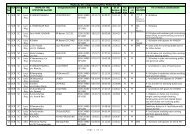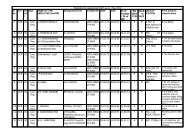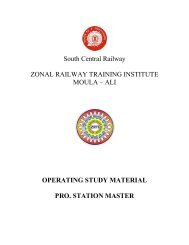BOGIES AND SUSPENSION - South Central Railway
BOGIES AND SUSPENSION - South Central Railway
BOGIES AND SUSPENSION - South Central Railway
Create successful ePaper yourself
Turn your PDF publications into a flip-book with our unique Google optimized e-Paper software.
CHAPTER 6 – <strong>BOGIES</strong> <strong>AND</strong> <strong>SUSPENSION</strong><br />
WAGON MAINTENANCE MANUAL<br />
Page 36 of 121<br />
The side frame casting is hollow. In larger portion it forms a box<br />
section and in some portion a “C” section. In the central portion of the casting,<br />
there is an opening to accommodate the spring nest and floating bolster. On<br />
either end of the casting on top, there is an extended portion called pedestal,<br />
which rests over axle box top surface. It has two holes for axle box bolts. On<br />
both bottom ends, there is an integrally cast bracket to secure the side frame<br />
tie bar. The latter is secured to the frame by three rivets. The bottom portion of<br />
the axle box rest on the tie bar. On the inner side of the casting, two brackets<br />
are integrally cast in the central top portion to suspend the brake beam hanger.<br />
The bottom surface of the top extended portion and the top surface of<br />
the bottom integrally cast bracket meant to secure axle box and tie bar<br />
respectively are finish machined. The centre opening, which receives the<br />
spring plank and bolster assembly, is filed rough ground at all places except<br />
on the top. The four axle box bolt holes in the extended portion are drilled.<br />
There are six holes in the central opening at the bottom to secure the spring<br />
plank by rivets. There are two holes in each of the integrally cast bracket to<br />
rivet the tie bar with it. Each of the four brackets meant to suspend the brake<br />
beam hanger has a hole. Bushes have been provided in the holes for wear and<br />
tear caused due to the pin.<br />
b) SPRING PLANK<br />
The spring plank is manufactured by pressing the steel plate of<br />
required thickness and size. The spring plank connects the two side frames and<br />
keeps the latter at a fixed distance. It ensures the squareness and correct<br />
alignment of the trolley.<br />
The same type of spring plank is used on the cast steel bogie. The<br />
vertical sides of spring plank are attached to the bogie column. In the case of<br />
MG bogie, the two brake beam support plates are riveted to the spring plank<br />
while in case of BG, a brake support channel is riveted to the spring plank<br />
through angle cleats. The brake push rod safety loops are riveted to spring<br />
plank in MG bogie while these are riveted to brake support channel in BG<br />
bogie.<br />
c) FLOATING BOGIE BOLSTER<br />
The fabricated design of bogie bolster in lieu of cast steel bolster is in<br />
use. The fabricated design fulfils all the requirements of cast steel bolster and<br />
both are freely interchangeable. The same type of floating bolster is used on<br />
diamond frame and casts steel bogie. It is fitted in transverse direction,<br />
perpendicular to the track.


